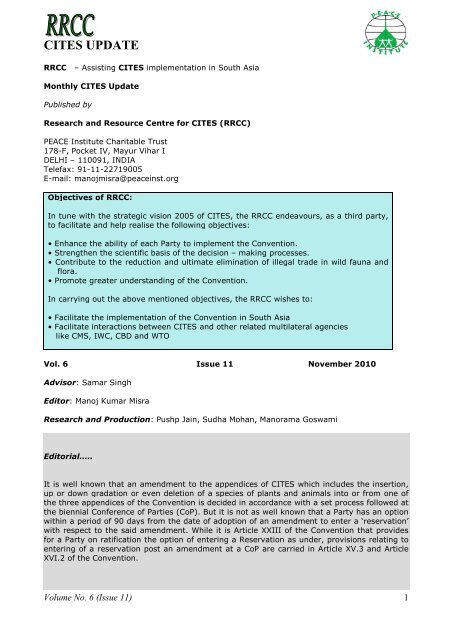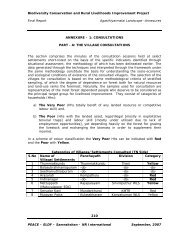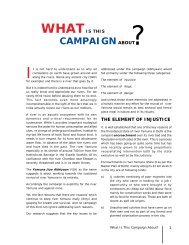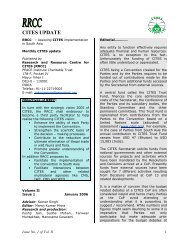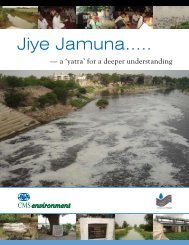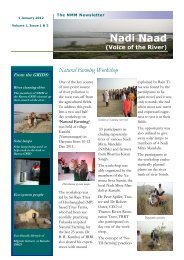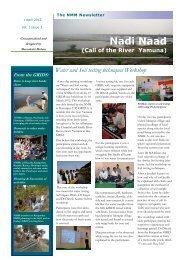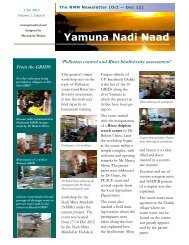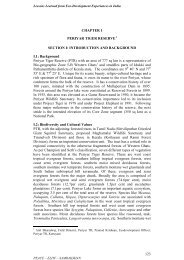11 - PEACE Institute Charitable Trust
11 - PEACE Institute Charitable Trust
11 - PEACE Institute Charitable Trust
You also want an ePaper? Increase the reach of your titles
YUMPU automatically turns print PDFs into web optimized ePapers that Google loves.
CITES UPDATE<br />
RRCC – Assisting CITES implementation in South Asia<br />
Monthly CITES Update<br />
Published by<br />
Research and Resource Centre for CITES (RRCC)<br />
<strong>PEACE</strong> <strong>Institute</strong> <strong>Charitable</strong> <strong>Trust</strong><br />
178-F, Pocket IV, Mayur Vihar I<br />
DELHI – <strong>11</strong>0091, INDIA<br />
Telefax: 91-<strong>11</strong>-22719005<br />
E-mail: manojmisra@peaceinst.org<br />
Objectives of RRCC:<br />
In tune with the strategic vision 2005 of CITES, the RRCC endeavours, as a third party,<br />
to facilitate and help realise the following objectives:<br />
• Enhance the ability of each Party to implement the Convention.<br />
• Strengthen the scientific basis of the decision – making processes.<br />
• Contribute to the reduction and ultimate elimination of illegal trade in wild fauna and<br />
flora.<br />
• Promote greater understanding of the Convention.<br />
In carrying out the above mentioned objectives, the RRCC wishes to:<br />
• Facilitate the implementation of the Convention in South Asia<br />
• Facilitate interactions between CITES and other related multilateral agencies<br />
like CMS, IWC, CBD and WTO<br />
Vol. 6 Issue <strong>11</strong> November 2010<br />
Advisor: Samar Singh<br />
Editor: Manoj Kumar Misra<br />
Research and Production: Pushp Jain, Sudha Mohan, Manorama Goswami<br />
Editorial…..<br />
It is well known that an amendment to the appendices of CITES which includes the insertion,<br />
up or down gradation or even deletion of a species of plants and animals into or from one of<br />
the three appendices of the Convention is decided in accordance with a set process followed at<br />
the biennial Conference of Parties (CoP). But it is not as well known that a Party has an option<br />
within a period of 90 days from the date of adoption of an amendment to enter a ‘reservation’<br />
with respect to the said amendment. While it is Article XXIII of the Convention that provides<br />
for a Party on ratification the option of entering a Reservation as under, provisions relating to<br />
entering of a reservation post an amendment at a CoP are carried in Article XV.3 and Article<br />
XVI.2 of the Convention.<br />
Volume No. 6 (Issue <strong>11</strong>) 1
CITES UPDATE<br />
According to Article XXIII (Reservations)<br />
1. The provisions of the present Convention shall not be subject to general reservations.<br />
Specific reservations may be entered in accordance with the provisions of this Article and<br />
Articles XV and XVI.<br />
2. Any State may, on depositing its instrument of ratification, acceptance, approval or<br />
accession, enter a specific reservation with regard to:<br />
(a) any species included in Appendix I, II or III; or<br />
(b) any parts or derivatives specified in relation to a species included in Appendix III.<br />
3. Until a Party withdraws its reservation entered under the provisions of this Article, it shall<br />
be treated as a State not a Party to the present Convention with respect to trade in the<br />
particular species or parts or derivatives specified in such reservation.<br />
It is the Article XV.3 of the Convention that provides for a reservation post an amendment at a<br />
CoP in the following manner:<br />
“During the period of 90 days provided for in subparagraph (e) of paragraph 1 or<br />
subparagraph (l) of paragraph 2 of this Article, any Party may, by notification in writing to the<br />
depository government (Switzerland), make a reservation with respect to the amendment.<br />
Until such reservation is withdrawn, the Party shall be treated as a State not Party to the<br />
present Convention with respect to trade in the species concerned.”<br />
It may be noted that as worded the reservation process suffers from a practical problem. For<br />
example if a species is through an amendment up listed from say Appendix II to I and a Party<br />
has a problem with such up listing and enters a reservation, it does not automatically means<br />
that the Party ceases to remain a Party to the Convention with respect to trade in the species<br />
concerned, since the same (Party) was already observing the Appendix II norms of<br />
international trade for the species concerned. This paradox needs to be resolved by the<br />
Convention. While resolution Conf.4.25 (rev Conf.14) (we carry its’ text elsewhere in the issue) has<br />
tried to deal with the issue it still needs a better clarification.<br />
Presently as on 23 June 2010, there are 93 reservations entered in respect of species listed in<br />
Appendix I; <strong>11</strong>5 in respect of species listed in Appendix II and 141 in respect of species listed<br />
in Appendix III. It is interesting to note that no Party from the south Asia region has a current<br />
reservation in place.<br />
The months of October and November 2010 would be recalled for two key events one of which<br />
has just concluded and the other is scheduled.<br />
The tenth CoP of the Convention on Biological Diversity (CBD) was held from 18-29 October<br />
2010 at Nagoya in Japan. The Secretary General of CITES made an intervention on 28 October<br />
in form of a statement read on behalf of the Secretariats of four biodiversity-related<br />
conventions (Ramsar; World Heritage; CMS and CITES). (We carry its text in the issue).<br />
An International Tiger Summit is planned from 21-24 November 2010 at St. Petersburg in the<br />
Russian Federation. (We shall report about this summit in our next issue).<br />
Happy reading….<br />
Manoj Misra<br />
Volume No. 6 (Issue <strong>11</strong>) 2
CITES UPDATE<br />
CONF. 4.25 (REV. COP14) : RESERVATIONS<br />
RECOGNIZING that, in accordance with Article XXIII of the Convention, a State may, when it<br />
becomes a Party to CITES, enter a reservation with respect to any species included in<br />
Appendix I, II or III, or any parts or derivatives specified in relation to a species included in<br />
Appendix III, and that, in this case, it shall be treated as a State not a Party to the Convention<br />
with respect to trade in the specified species or parts or derivatives until it withdraws such<br />
reservation;<br />
RECOGNIZING that, when Appendix I or II is amended in accordance with Article XV of the<br />
Convention, any Party may, within 90 days, make a reservation with respect to the<br />
amendment, and that, in this case, it shall be treated as a State not a Party to the Convention<br />
with respect to trade in the species concerned until such reservation is withdrawn;<br />
RECOGNIZING FURTHER that, in accordance with Article XVI of the Convention, any Party may<br />
at any time enter a reservation with respect to a species included in Appendix III or any<br />
specified parts or derivatives, and that, in this case, the State shall be treated as a State not a<br />
Party to the Convention with respect to trade in the species or part or derivative concerned<br />
until such reservation is withdrawn;<br />
NOTING that there have been different interpretations of these provisions of the Convention<br />
by Parties;<br />
BELIEVING that the transfer of a species from one Appendix of the Convention to another<br />
must be viewed as a deletion from one Appendix and its simultaneous inclusion in the other;<br />
CONSIDERING that, if a species is deleted from the Appendices, any reservation entered in<br />
relation to that species ceases to be valid;<br />
CONSIDERING also that all Parties should interpret the Convention in a uniform manner;<br />
THE CONFERENCE OF THE PARTIES TO THE CONVENTION<br />
RECOMMENDS that any Party having entered a reservation with regard to any species included<br />
in Appendix I treat that species as if it were included in Appendix II for all purposes, including<br />
documentation and control;<br />
AGREES that, if a species is deleted from one Appendix of the Convention and simultaneously<br />
included in another, the deletion shall render invalid any reservation that was in effect in<br />
relation to the species and, consequently, any Party that wishes to maintain a reservation in<br />
relation to the species must enter a new reservation in accordance with Article XV,<br />
paragraph 3, or Article XVI, paragraph 2;<br />
CALLS on the Parties having entered reservations to nevertheless maintain and communicate<br />
statistical records on trade in the species concerned, as part of their annual reports, so that<br />
international trade in specimens of these species may be properly monitored; and<br />
INSTRUCTS the Secretariat to remind affected Parties explicitly of the reservations that will be<br />
rendered invalid, in time for the Parties to renew their reservations if they so desire.<br />
Volume No. 6 (Issue <strong>11</strong>) 3
CITES UPDATE<br />
NEWS<br />
1. Statement to the High-Level Segment of CBD-COP 10 in Nagoya on 28 October<br />
2010<br />
Intervention by the Executive Heads of the Secretariats of the: Convention on Wetlands of<br />
International Importance; Convention Concerning the Protection of the World Cultural and<br />
Natural Heritage; Convention on International Trade in Endangered Species of Wild Fauna and<br />
Flora; and Convention on Migratory Species. Delivered by the Secretary-General of CITES:<br />
“Your Excellency, President of the COP, Honorable Ministers, Executive Secretary of the CBD,<br />
distinguished delegates, ladies and gentlemen.<br />
I have the honour of presenting an agreed joint statement on behalf of the Secretariats of four<br />
biodiversity-related conventions, namely the: Ramsar Convention, World Heritage Convention,<br />
CITES and CMS.<br />
Each of the conventions I am speaking for today has a very specific mandate, and while they<br />
may be more targeted in scope than the CBD, they contribute towards achieving the same<br />
objectives of supporting the conservation and sustainable use of biodiversity.<br />
They are longstanding, complementary and effective tools, designed to be highly operational<br />
and to make a difference on-the-ground – with each having between <strong>11</strong>4 and 187 Parties. And<br />
it is through these Conventions that the international community has:<br />
- provided the framework for national action and international cooperation for the<br />
conservation and wise use of wetlands and their resources1;<br />
- put in place a scheme for the identification, protection, conservation, presentation and<br />
transmission to future generations of the world’s cultural and natural heritage2;<br />
- created a robust regulatory regime to ensure that no species of wild fauna or flora is subject<br />
to unsustainable exploitation through international trade3; and<br />
- established the framework for the conservation of migratory species, their habitats and<br />
migratory routes4.<br />
Distinguished delegates,<br />
As you can see, while we may have unique histories and mandates, and in some cases<br />
different Parties, we are joined by a common objective of supporting the conservation and<br />
sustainable use of biodiversity, and by a collective desire to see more effective implementation<br />
of conventions at the country level, including through making best use of National Biodiversity<br />
Strategy and Action Plans.<br />
The Secretariats of five biodiversity-related conventions met last month, in a retreat convened<br />
by the Executive Secretary of CBD, to prepare for this COP5. Amongst other matters, we<br />
supported6 the adoption of an inclusive strategic plan for biodiversity and agreed that National<br />
Biodiversity Strategy and Action Plans should cover the full range of activities needed to<br />
implement biodiversity-related conventions.7<br />
If adopted at COP 10, this approach would help to achieve greater effectiveness and<br />
coherence with the implementation of these conventions at the national level. It would also<br />
enhance the ability of countries to use existing financial resources more effectively, including<br />
most importantly resources available to Parties under the GEF, and to attract additional<br />
financing.<br />
States have already invested significant time, effort and financial resources into the<br />
negotiation, ratification and implementation of each biodiversity-related convention, with<br />
major milestones having been achieved in Stockholm in 1972 and Rio de Janeiro in 1992.<br />
Volume No. 6 (Issue <strong>11</strong>) 4
CITES UPDATE<br />
And while we may not have met the 2010 target set in Johannesburg in 2002, the valuable<br />
contribution of each of our conventions towards meeting the agreed subsidiary targets has<br />
been critical, as is reflected in the findings of GBO 3.<br />
We need to recognize and learn from this vast body of experience in considering the 2020<br />
targets, as we continue to build on the scientific, legislative, administrative, and other<br />
capacities that have been progressively built to implement these conventions over the past 40<br />
years.<br />
Distinguished delegates,<br />
States are sovereign and determine their own international commitments, and the national<br />
activities they wish to prioritize. Equally, each convention’s COP is sovereign and therefore<br />
determines its own strategies. Decisions about these matters will properly vary from country<br />
to country and convention to convention, but the strategy for biodiversity adopted at this<br />
meeting should provide a framework that is relevant to all of them.<br />
We believe that the adoption of an inclusive strategic plan with robust and relevant targets8<br />
that enables the reality of each country to be reflected through their National Biodiversity<br />
Strategy and Action Plans, will contribute towards more coherent and effective on-the-ground<br />
action. On behalf of the Secretariats of the Ramsar Convention, World Heritage Convention,<br />
CITES and CMS, I sincerely thank you President and wish Parties well for a successful COP.<br />
2. Remarks by John E. Scanlon, Secretary-General, Convention on International<br />
Trade in Endangered Species of Wild Fauna and Flora (CITES) made during the<br />
Global Tiger Initiative side-event at the 10th meeting of the Conference of the<br />
Parties to the Convention on Biological Diversity Nagoya, Japan, 28 October 2010<br />
The subject of conservation of tigers is one that the CITES community has given a special<br />
focus to over many years. The CITES Secretariat has also been a very active player in the<br />
Global Tiger Initiative, since the President of the World Bank asked the Secretariat to take the<br />
lead in providing enforcement-related advice to the Initiative.<br />
Many of the pressures that tigers currently face, such as loss of habitat, conflict with humans<br />
and their livestock, and a declining prey base, are being addressed by others. It is in the fields<br />
of regulating trade, or combating illegal trade, that the expertise of CITES has been called<br />
upon.<br />
This event takes place during the Chinese Year of the Tiger, the International Year of<br />
Biodiversity and during this meeting of the Conference of the Parties to the Convention on<br />
Biological Diversity. It is an appropriate time and place to focus on the tiger as one of our<br />
planet’s flagship species. The well-being of the tiger reflects the health (or otherwise) of the<br />
forests and jungles in which it lives. Regrettably, the ever-declining numbers of tigers tell us<br />
that many of those habitats are similarly under pressure.<br />
In 1999, a CITES technical mission team visited 14 tiger range States, and what we refer to as<br />
consumer States. It found that the law enforcement officers tasked with protecting tigers in<br />
the wild and combating illegal trade in these magnificent creatures were often underresourced,<br />
poorly paid, and inadequately trained. Many of the Team’s conclusions and<br />
recommendations remain valid and relevant today, despite a decade having passed.<br />
Good enforcement work is being conducted but obviously not often enough. This is particularly<br />
frustrating if one acknowledges that illegal trade in tigers is not especially widespread. Much of<br />
it appears to be conducted by a relatively limited number of individuals or groups and is<br />
Volume No. 6 (Issue <strong>11</strong>) 5
CITES UPDATE<br />
destined for specialized markets or consumers. Although some of these markets and<br />
consumers are clandestine in nature, they are nonetheless open to infiltration and targeting.<br />
The CITES Secretariat believes that much of today’s illegal trade in tigers could be markedly<br />
reduced, if concerted, collective efforts were made by the law enforcement community against<br />
those involved in these destructive crimes.<br />
It was with a view to bringing support to the law enforcement community that the CITES<br />
Secretariat promoted the concept of what has come to be known as the International<br />
Consortium on Combating Wildlife Crime (ICCWC). The Consortium, intended to consist of<br />
CITES, INTERPOL, the United Nations Office on Drugs and Crime, the World Bank, and the<br />
World Customs Organization, aims to introduce a new era of wildlife law enforcement, one<br />
where wildlife criminals will face a formidable, coordinated opposition, rather than the present<br />
situation where the risk of detection and punishment is all too low. To achieve this goal,<br />
ICCWC is intended to work for, and with, the national-level wildlife law enforcement<br />
community, since it is these frontline officers who bring criminals to justice.<br />
It is our fervent hope that the forthcoming International Tiger Forum in St Petersburg will see<br />
the formal launch of the Consortium. As many of you will know, the potential support offered<br />
by agencies involved in the Consortium now features as a major component of the Global<br />
Tiger Recovery Program, which representatives of tiger range States will be asked to endorse<br />
in St Petersburg. We need to bring our collective efforts together to assist national authorities<br />
tackle this growing area of criminal activity if we are to achieve our biodiversity targets.<br />
Enforcement alone will not, of course, save the tiger. But it is significant that it is seen as a<br />
very high priority by the range States and the wider conservation community. We’ve noted<br />
this emphasis with regard to other CITES Appendix I species which are threatened with<br />
extinction, such as the mountain gorilla in Africa.<br />
Eco-tourism has been helpful in safeguarding mountain gorillas and it can be helpful for tigers<br />
in some of their habitats also. But we should not be shy about also emphasizing the<br />
importance of effective enforcement. After all, every tiger skin that enters into trade and every<br />
tiger skeleton that crosses a border shows that our conservation management has failed and<br />
brings the species ever closer to extinction.<br />
Good enforcement work is being done and today I want to tell you about one excellent<br />
example. On 23rd August this year, at Bangkok’s international airport, a passenger’s baggage<br />
was subjected to X-ray screening. The airport security staff became suspicious of the contents<br />
and they summoned the CITES officials that are stationed at the port. When the baggage was<br />
searched, it was found to be full of stuffed tiger toys, the type of object that a child would<br />
cuddle. However, to their astonishment, hidden within these toy tigers was a real live tiger<br />
cub. Needless to say, the traveller was arrested and the tiger was seized and is being cared<br />
for.<br />
It is clearly commendable that this poor animal was prevented from being traded illegally.<br />
However, what is really commendable is that the airport security staff in Bangkok has been<br />
specifically trained to be alert to the smuggling of wildlife. They were trained by the<br />
Programme Coordination Unit of ASEAN-WEN (the wildlife enforcement network that has been<br />
established among the countries of South East Asia), with support from the wildlife monitoring<br />
NGO TRAFFIC and the United States Agency for International Development.<br />
I’m delighted that the Minister of Natural Resources and Environment of Thailand, The<br />
Honourable Suwit Khunkitti who was recently awarded the J. Paul Getty Award for<br />
Conservation Leadership, is with us today. He initiated and chaired the 1st Asia Ministerial<br />
Conference on Tiger Conservation hosted by the Government of Thailand in cooperation with<br />
the Global Tiger Initiative in early this year. I’m also delighted, because I’d like to announce<br />
that we have decided that the Airports of Thailand Public Company and the CITES Wildlife<br />
Volume No. 6 (Issue <strong>11</strong>) 6
CITES UPDATE<br />
Checkpoint of the National Parks, Wildlife and Plant Conservation Department of the<br />
Government of Thailand, at Bangkok airport, are to be awarded the CITES Secretary-General’s<br />
Certificate of Commendation. Certificates of Commendation are awarded in recognition of<br />
exemplary enforcement activities, and the seizure of the tiger cub undoubtedly offers an<br />
excellent example to other countries. I hope that more governments will move to raise<br />
awareness of wildlife smuggling among their port security staff and I look forward to<br />
presenting the Certificates personally, when I visit Thailand, which will host the CITES COP16<br />
in 2013, later this year<br />
I’m firmly convinced that, if we get things right for the tiger, we will also get things right for<br />
its habitats and the fauna and flora which are found there.<br />
I’d like to close by thanking:<br />
- the organizers of this event for their invitation to speak;<br />
- the World Bank for all its efforts in relation to the Global Tiger Initiative, and especially its<br />
President, Robert Zoellick, for the strong personal leadership, passion and enthusiasm he is<br />
bringing to this excellent collaboration to save the remaining wild tigers;<br />
- Minister Suwit for his personal commitment to conservation and his country’s commitment to<br />
CITES and congratulating again Thailand’s officials for saving one particular tiger; and<br />
- saying how honoured CITES staff are to be playing a role in tiger conservation.<br />
Finally, future generations should not have to look at tigers behind bars in a zoo. Instead, it is<br />
those criminals who poach and trade tigers that should be the ones behind bars.<br />
CITES NOTIFICATIONS<br />
(Here we carry the operational part of Notifications issued by the CITES Secretariat that bear relevance to the Parties<br />
in South Asia – Editor)<br />
NOTIFICATION No. 2010/028 dated 15 October 2010<br />
CONCERNING: Reservations<br />
1. The Depositary Government (the Government of the Swiss Confederation) has informed<br />
the Secretariat that, within the deadline foreseen in the text of the Convention, Canada<br />
entered a reservation with respect to the amendments to Appendices I and II adopted by<br />
the Conference of the Parties at its 15th meeting (CoP15, Doha, 2010), as a result of the<br />
necessity to complete its domestic legal requirements for the entry into force of these<br />
amendments.<br />
2. The above information was communicated officially to the signatory and acceding States of<br />
the Convention through a Notification from the Depositary Government.<br />
3. The Secretariat has revised the list of current reservations to incorporate the reservations<br />
entered by Canada and to follow the standard nomenclatures adopted at CoP15 [listed in<br />
Resolution Conf. 12.<strong>11</strong> (Rev. CoP15)]. In addition, the annotations have been updated to<br />
reflect the amendments adopted at that meeting.<br />
4. The current list of reservations entered by Parties is annexed to this Notification and is<br />
available on the CITES website under ‘Official documents / Reservations’.<br />
Volume No. 6 (Issue <strong>11</strong>) 7
CITES UPDATE<br />
NOTIFICATION No. 2010/030 dated 28 October 2010<br />
CONCERNING: Secretary-General’s Certificate of Commendation<br />
1. In 2002, the Secretariat advised the Parties of the introduction of certificates of<br />
commendation that would be issued, at the Secretary-General’s discretion, to recognize<br />
exemplary actions related to enforcement.<br />
2. The latest such Certificates are to be awarded to the Airports of Thailand Public Company<br />
and the CITES Wildlife Checkpoint of the National Parks, Wildlife and Plant Conservation<br />
Department of the Government of Thailand, at Suvarnabhumi Airport, Bangkok.<br />
3. The Certificates are being awarded in recognition of a seizure, made at Suvarnabhumi<br />
Airport on 23 August 2010, when officials of the two agencies discovered a person<br />
attempting to smuggle a live tiger cub out of the country. The tiger had been carefully<br />
concealed in baggage but was discovered during X-ray screening.<br />
4. It is commendable, especially during the Chinese Year of the Tiger and at a time when the<br />
species is under threat of extinction, that this live tiger was prevented from being traded<br />
illegally.<br />
5. Additionally, this seizure demonstrates the importance of raising awareness of illegal trade<br />
in wildlife among port security personnel, who are ideally placed to detect instances of<br />
smuggling. The CITES Secretariat notes that such personnel in Thailand have received<br />
training of this nature, which was delivered by the ASEAN Wildlife Enforcement Network’s<br />
Programme Coordination Unit and TRAFFIC, and funded by USAID.<br />
6. The date and venue for the presentation of the certificates have yet to be decided.<br />
CITES CALENDAR<br />
(We carry here information about such events in the CITES calendar which directly impact or relate to the CITES<br />
Parties in South Asia region - Editor)<br />
8-<strong>11</strong> November 2010: 79th INTERPOL General Assembly, Doha, Qatar<br />
21-24 November 2010: International Tiger Summit, Saint Petersburg, Russian Federation<br />
6-7 December 2010: 9th meeting of the MIKE Technical Advisory Group, Nairobi, Kenya<br />
9-<strong>11</strong> January 20<strong>11</strong>: Non-detriment findings and the Review of Significant Trade for Plant<br />
species, Kathmandu, Nepal<br />
31 January 20<strong>11</strong> - Deadline set in Resolution Conf. 10.10 (Rev. CoP14) for Parties that hold a<br />
stock of raw ivory within their territory to inform the Secretariat of the level of that stock,<br />
indicating the source of the ivory<br />
17 February 20<strong>11</strong> - Deadline for the submission of documents for the 19th meeting of the<br />
CITES Plants Committee<br />
18-21 April 20<strong>11</strong> - 19th meeting of the CITES Plants Committee, Geneva, Switzerland<br />
19 May 20<strong>11</strong>: Deadline for the submission of documents for consideration at the 25th meeting<br />
of the CITES Animals Committee<br />
16 June 20<strong>11</strong>: Deadline for the submission of documents for consideration at the 61st meeting<br />
of the CITES Standing Committee<br />
Volume No. 6 (Issue <strong>11</strong>) 8
CITES UPDATE<br />
18-22 July 20<strong>11</strong>: 25th meeting of the CITES Animals Committee, Geneva, Switzerland<br />
15-19 August 20<strong>11</strong> - 61st meeting of the CITES Standing Committee, Geneva, Switzerland<br />
NOTABLE SEIZURES<br />
(We carry here relevant information on recent seizures of wildlife items from countries in South Asia region – Editor)<br />
Poacher held (Source: The Hindu, Chennai, 21 September 2010)<br />
The anti-naxal operation team of Theni and Dindigul districts has secured a poacher of<br />
Virudhunagar district.<br />
V. Balakrishnan, Superintendent of Police, Theni district, said following a tip-off that Vanaraj<br />
was in possession of a country-made weapon, a police team arrested him from his house at<br />
Watrap more than a fortnight ago. A case under Section 25 (1) A of the Indian Arms Act has<br />
been registered. When contacted, Forest Department sources said Vanaraj was suspected to<br />
be involved in poaching in Varushanadu and Vellimalai forest areas in Theni district. He was<br />
also allegedly involved in ganja cultivation in interior forest areas.<br />
Another forest officer said Vanaraj would go to interior forest areas after 7 p.m. Once an<br />
animal was killed he would skin it and dispose of the skin safely. He would return home early<br />
in the morning. His main targets were spotted deer, sambar, Nilgiri Tahr and Nilgiri Langur.<br />
The deer species were killed for their meat and the Nilgiri Langur for medicinal properties. He<br />
used to charge up to Rs.10,000 for a Nilgiri Langur and, over the last few years, had created a<br />
network in Theni, Virudhunagar and surrounding areas.<br />
60 poachers caught off Andamans (25 September 2010)<br />
The Indian Coast Guard has apprehended as many as 60 Myanmarese poachers off the<br />
Andamans islands in less than a week. The poachers were trying to extract molluscs and sea<br />
cucumbers, which fetch high prices in international market because of their medicinal qualities<br />
and are abundantly available off the Andamans.<br />
Giving details here on Friday, a Coast Guard official said, on September 22 its ship Aruna Asaf<br />
Ali detained two boats and caught 24 poachers. While undertaking a routine patrol in the<br />
Northern Andaman Sea the ship’s Commandant, Vijay Singh, noticed suspicious movement of<br />
two boats, away from each other by five miles, approaching from the direction of the Coco<br />
Islands.<br />
As the CGS Aruna Asaf Ali chased one boat, the other boat tried to slip away and was caught<br />
after a high-speed chase and warning shots. Over the last weekend, between September 18<br />
and September 20, the ship apprehended a total of 36 poachers from three boats. All the<br />
boats carried sufficient fuel and provisions to sustain at sea for prolonged duration and were<br />
equipped with diving equipment.<br />
The Coco Islands in Myanmar, which is just about 26 nautical miles from the Indian territorial<br />
waters, makes it easier for poachers to sneak into the Indian waters. Following heightened<br />
surveillance and vigil by the Coast Guard ships, helicopters and Dornier surveillance aircraft<br />
along the Andamans archipelago, the ICG has apprehended 88 Myanmarese poachers<br />
alongwith seven boats this month.<br />
Volume No. 6 (Issue <strong>11</strong>) 9
CITES UPDATE<br />
3 ‘poachers’ arrested, antlers seized (Source: Indian Express, New Delhi, 4 October 2010)<br />
Muzaffarnagar: Three persons were arrested on poaching allegations and about nine quintals<br />
of antlers were seized from their possession in Saharanpur district, police said on Sunday.<br />
Acting on a tip-off, police raided a house at Behat town in the district on Saturday and<br />
recovered about nine quintals of antlers of chital, barasingha, sambar and wild deer from it.<br />
The three were arrested and a case was registered against them under various sections of<br />
Wild Life Protection Act, 1972.<br />
Two arrested with leopard skins (Source: Deshbandhu, New Delhi, 4 October 2010)<br />
Shivpuri: The police at Shivpuri in Madhya Pradesh arrested two poachers with two skins of<br />
leopard. The accused had planned to sell the skins in Rajasthan.<br />
Elephant tusks worth Rs. 4 lakh seized near Dadar Station (Source: DNA, Mumbai, 13<br />
October 2010)<br />
The Matunga police on Monday night arrested a 40-year-old man for possession of two<br />
elephant tusks concealed in a polythene bag outside Dadar railway station.<br />
“The accused was identified as Ashok Maru, 40, a resident of Kurla. He was working as a<br />
sweeper in a private building in Byculla. The police seized two elephant tusks, collectively<br />
valued at Rs4 lakh, from him,” said senior police inspector Sunil Deshmukh of Matunga police<br />
station.<br />
Deshmukh added that Maru, who was booked under various sections of the wildlife protection<br />
Act, was remanded in police custody till October 15 by the Kurla metropolitan magistrate’s<br />
court on Tuesday.<br />
The Matunga police had received information that a person carrying elephant tusks would<br />
arrive outside the Dadar railway station (East) to meet a customer. Based on the information,<br />
API Srikant Ramdasi and staff laid a trap in the vicinity around <strong>11</strong>pm, and nabbed Maru redhanded<br />
with the elephant tusks.<br />
“We are conducting an inquiry into the matter, as to who he brought the tusks from and to<br />
whom he wanted to deliver in Mumbai,” said Deshmukh.<br />
During his interrogation, Maru was asked from where he managed to get the tusks. He<br />
claimed that an Arab national used to live in the Byculla building where he works. It was in his<br />
home that he claimed to have found the tusks.<br />
The police have rubbished his claims, adding that Maru has no previous criminal record.<br />
Man caught with leopard skin, horns of black deer (Source: The Pioneer, New Delhi, 18<br />
October 2010)<br />
One person was arrested with a leopard skin and nine horns of black deer in Hamirpur, said<br />
district Police chief Kuldip Sharma. He said that the skin and horns were worth several lakhs of<br />
rupees.<br />
Sharma said that at a barricade at Beas Bridge near Sujanpur tira, the police intercepted a<br />
man with a huge bag. Police party on duty asked him to open the back. However, the man<br />
tried to run away from the scene and was chased by the police. When the bag was opened,<br />
horns of black deer and a skin of leopard were found inside the bag.<br />
He said a case under Section 52 of Wild life Act and 379 of Indian Penal Code has been<br />
registered against the man identified as Shyam Lal of Paniala village of Bilaspur district.<br />
Volume No. 6 (Issue <strong>11</strong>) 10
CITES UPDATE<br />
Sharma said that the police is still interrogating the accused as the police is suspecting the<br />
involvement of a gang in the State involved in such business.<br />
He said that the police was optimistic that it would break the nexus operating in various parts<br />
of Hamirpur, Kangra, Una, Bilaspur and Mandi districts of the State and doing the business of<br />
selling skins and other important parts of the wild life animals.<br />
Show poachers no mercy, SC tells govt (Source: The Tribune, New Delhi, 21 October<br />
2010)<br />
New Delhi, October 20: Pointing out that the tiger, the mascot of the just-concluded<br />
Commonwealth Games, and several other endangered species were on the brink of extinction<br />
in India, the Supreme Court today asked the Centre and states to crack down on poachers<br />
responsible for the $20 billion international trade in wildlife products.<br />
Dismissing an appeal filed by notorious poacher Sansar Chand, the Bench observed that the<br />
case revealed how “avaricious and rapacious persons have by organised crime destroyed large<br />
parts of the wildlife of India and brought many animals like tigers, leopards and bison almost<br />
to the brink of extinction, thereby seriously jeopardising and destroying the ecological chain<br />
and ecological balance in our environment.”<br />
“Shera was the symbol of the recent Commonwealth Games but, ironically, Shera has been<br />
almost exterminated in our country. The Sher Khan of Rudyard Kipling’s Jungle Book, which<br />
once abounded in India, is rarely to be seen today,” a Bench comprising Justices Markandey<br />
Katju and TS Thakur began the judgment.<br />
“We would like to request the Central and state governments and their agencies to make all<br />
efforts to preserve the wildlife of the country and take stringent actions against those who are<br />
violating the provisions of the Wildlife (Protection) Act, as this is necessary for maintaining the<br />
ecological balance in our country,” the Judges said.<br />
At one time, India had one of the richest and most varied fauna in the world. However, over<br />
the last several decades there has been a rapid decline of India’s wild animals and birds<br />
“which is a cause of grave concern.” “Some wild animals and birds such as cheetah had<br />
already become extinct,” Justice Katju noted while writing the verdict.<br />
Many sanctuaries and parks “are empty or almost empty of animals and birds. Thus, the<br />
Sariska Tiger Reserve in Rajasthan and the Panna Tiger Reserve in Madhya Pradesh today<br />
have no tigers. One of the main causes for this depredation of the wildlife is organised<br />
poaching which yields enormous profits by exports to China and other countries,” the apex<br />
court noted. The Bench also pointed out that poaching also had grave consequences on<br />
farming.<br />
Poacher shot dead in Rajaji Park (Source: The Pioneer, New Delhi, 22 October 2010)<br />
Rajaji National Park director SS Rasaily said on Thursday that a forest department employee<br />
who was patrolling the area encountered a group of about a dozen persons armed with spears<br />
and firearms atop a ridge in the Dhaulkhand area which is part of the core zone of the national<br />
park. When challenged, one of them opened fire at the forest guard. The guard fired a round<br />
in the air to scare the intruders away. But the bullet hit a resident of Bullawala village, Babu<br />
Lal, who died, while others in the group escaped.<br />
Volume No. 6 (Issue <strong>11</strong>) <strong>11</strong>
CITES UPDATE<br />
The director claimed that the group had entered the core zone with the intention of poaching<br />
and had taken Babu Lal along as a guide and for the task of skinning and cutting the animal<br />
that they poached.<br />
The forest guard had fired in self-defence on Wednesday, it was stated. The RNP director said<br />
the man was part of a group of persons who had entered the core zone of RNP with the<br />
intention of poaching, especially tigers which are known to inhabit the Dhaulkhand area.<br />
The police has, however, registered a case of murder against the Rajaji National Park director<br />
for the death of Babu Lal, because a large number of villagers had reached the site of the<br />
incident when the RNP director and Doiwala SHO were on the spot. Some of the villagers<br />
alleged that Babu Lal had gone to the forest to collect grass used for making brooms.<br />
However, the RNP director denied these claims while countering the villagers’ claim that the<br />
men had entered the forest area to collect grass. According to Rasaily, it is strange that the<br />
group of persons carrying spears and a firearm travelled a distance of about 15 km from the<br />
village through rough jungle terrain and crossed a ridge purportedly to cut and collect a type<br />
of grass which is found commonly in various areas, including on the outskirts of the village.<br />
The Dhaulkhand area, which is part of the core zone of the RNP, is known for tigers.<br />
The RNP administration also plans to file an FIR against the persons who were part of the<br />
group of poachers involved in the altercation which resulted in the death of Babu Lal.<br />
NB: We would like to mention that we report seizures and news as they are reported in the media. While we do try to<br />
ascertain the correctness of the reports that we carry, we do not take any responsibility for the correctness or<br />
otherwise of the information as it is put out by the newspapers. We would nevertheless be glad to carry in our<br />
subsequent issue/s any correction to a report carried by us that any of our esteemed reader may like to bring to our<br />
notice – Editor)<br />
Volume No. 6 (Issue <strong>11</strong>) 12


